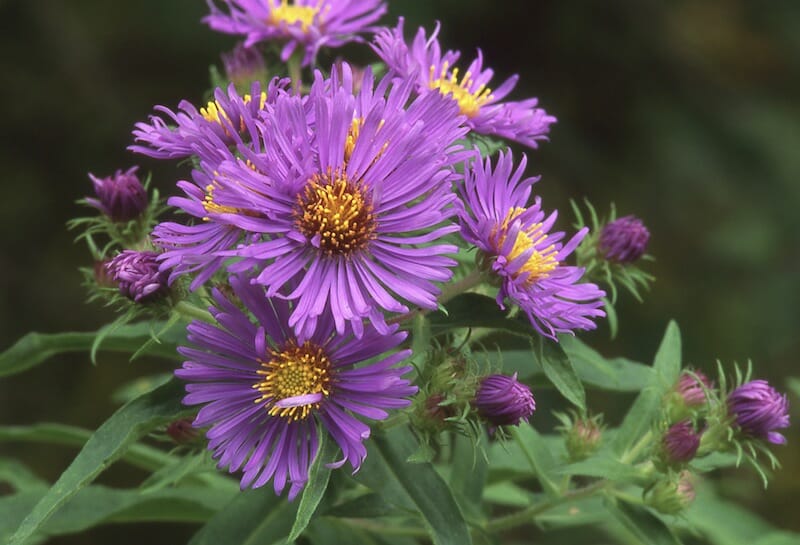
Perennial Plant Feature Fall Asters
PERENNIAL PLANT FEATURE FALL ASTERS
Dr. Leonard Perry, Extension Professor
University of Vermont
There are many reasons to use fall-blooming asters in landscapes. There is much variety in this large group of hardy perennials, coming in various heights and showy flower colors. You’ll find selections in all shades of red, pink, purple, white, and even blue. They’re easy to grow, most are native, and they’re one of the main plants for bees, butterflies and other pollinators in the fall. They combine well with ornamental grasses, rudbeckia, and coneflowers.
With so many to choose from, how does one begin? In addition to favorite colors, look for ones that best fit your growing conditions, desired habits, and that have disease resistance.
The starburst appearance of the flowers leads to the name “aster”, from the Greek word for star. Asters give their name to the large composite family— Asteraceae— that of sunflowers, dahlias, daisies, zinnias, and similar flowers. The asters all used to be grouped together into one “genus” (Aster), but thanks to recent botanical research they’ve been regrouped with names more suited to botanists than gardeners. So for instance, although the New England aster genus is now changed (Symphyotrichum), the species name has remained the same (novae-angliae).
Generally, most asters prefer moist, well-drained soil and full sun. There is a range of species, however, that can be grouped by their native environments and corresponding garden preferences. The first group prefers rich, moist soil in full sun. These include the species native to meadows, prairies and marshes such as the New York (S. novi-belgii), New England (S. novae-angliae), and flat-topped (D. umbellata) asters. They prefer steady moisture. Ones that prefer moist soil, but can tolerate dry sites, include the sky-blue (S. oolentangiense), heath (S. ericoides), calico (S. lateriflorum), aromatic (S. oblongifolium), and silky (S. sericeum) asters. Tatarian aster (A. tataricus) in this group, a Siberian native, is quite adaptable to various soils.
 The second group of asters also prefer full sun, along with cool nights, and very well-drained soil. This is because they are native to seashores and mountains where soil drainage is excellent. They may be short-lived over only a few years, particularly if conditions aren’t just right. In this group you’ll find the European Michaelmas daisy native to Asia Minor (A. amellus)—a name often given to many asters as they bloom around this Christian holiday of September 29. Others in this group are the Frikart’s (A. xfrikartii) aster, of garden origin, and East Indies (A. tongolensis) aster native to western China and India.
The second group of asters also prefer full sun, along with cool nights, and very well-drained soil. This is because they are native to seashores and mountains where soil drainage is excellent. They may be short-lived over only a few years, particularly if conditions aren’t just right. In this group you’ll find the European Michaelmas daisy native to Asia Minor (A. amellus)—a name often given to many asters as they bloom around this Christian holiday of September 29. Others in this group are the Frikart’s (A. xfrikartii) aster, of garden origin, and East Indies (A. tongolensis) aster native to western China and India.
The third group of native aster species tolerate shade (under 4 hours direct sun per day), but bloom better in part shade (4 to 8 hours of direct sun). The blue wood aster (S. cordifolium), Drummond’s aster (S. drummondii), white wood aster (E. divaricata), and big leaf aster (A. macrophyllus) are in this group. Although they prefer moist soils rich in organic matter (humus), they will tolerate some drought.
In perennial trials at the Chicago Botanic Gardens, 119 asters were evaluated over six years. They were rated based on flowering, health, habit, and hardiness. In this USDA zone 5 site (-10 to -20 degrees F average winter minimum), seven asters stood out with five-star ratings. These top asters included ‘Jin Dai’ tatarian aster, white wood aster and its cultivar (cultivated variety) ‘Eastern Star’, ‘Snow Flurry’ heath aster, calico aster and its cultivar ‘Lady in Black’, and ‘Raydon’s Favorite’ aromatic aster. For a rock garden or low wall, where cascading stems are desired, ‘Snow Flurry’ would be a good choice. For perennial gardens and naturalistic landscape masses, good choices would include asters with bushy habits—’Jin Dai’, ‘Lady in Black’, or ‘Raydon’s Favorite’.
In addition, there were 19 asters that rated good, with four stars. These good asters included a couple of New England asters—the rosy pink ‘Harrington’s Pink’ and deep pink ‘Honeysong Pink’, and three New York asters– the light lavender ‘Blaubox’, lavender-blue ‘Climax’, and purple-pink ‘Rosenwichtel’. Most selections you may find of the asters are in the New York and New England species. Perhaps the reasons that more didn’t rate more highly relate to habit and potential problems. Aromatic asters tend to be less problem-prone, and good alternative choices.
New England asters can get to four to five feet tall and fall over under some conditions, particularly low light. Cutting them back in early summer by one third to one half will make them more bushy, with no need to stake.
One of the more recent introductions of New England asters, and one of the most popular asters, ‘Purple Dome’ came from the Mt. Cuba Center and gardens in Delaware. It is violet-purple and low, only growing to about 16 inches high and about 2 feet wide. This makes it a good choice for fronts of borders, along walks, massed, or even containers. It bloomed over two months in Chicago, from early September to early November. ‘Vibrant Dome’ is a bright pink sport of this compact cultivar, not in these trials but popular and available.
‘Purple Dome’ is a good example of how resistance to diseases can vary by site. Often considered to have excellent resistance to powdery mildew, in the Chicago trials this cultivar was only rated as fair.
Asters may get rust or powdery mildew diseases on leaves. The former was seen more on the New York asters in the Chicago trials, while the latter disease was seen more on the New England asters. Giving good air circulation around plants, and disposing of leaves in the fall (not in the compost) will help lessen these. There are several sprays, organic and synthetic, that can be used for these too.
A main destructive insect of asters may be the lacebug, a small grayish insect that appears in midsummer and sucks the plant juices from the undersides of leaves, primarily of the New York and related types. Leaves turn yellowish and eventually brown and fall off. Organic or synthetic insect sprays can be used for control. Read and follow all label directions for best control, and safety for you and the environment.
Deer and rabbits can be quite fond of asters, too. There are repellent sprays for these. Low fencing for rabbits, and deer netting for these may be needed if repellents don’t work. Keys are to train these animals early in the season, and to rotate among more than one repellent strategy or spray.
Several asters have been bred as alternatives to fall garden mums, including the lavender ‘Ariel’, violet ‘Celeste’, and the purple ‘Pixie Dark’. Results from the Chicago trials show these only live a year or two, so should be grown as annual flowers. Since the New York asters have problems, and are short-lived, they are not recommended either, even though commonly found.
Keeping asters healthy during the growing season—in part, growing them under the right conditions– will go a long way toward helping them survive the subsequent winter. More on asters and their culture, as well as other perennial evaluations, can be found in the reports from trials manager Richard Hawke and his Chicago Botanic Garden trials website (www.chicagobotanic.org/research/plant_evaluation).
Distribution of this release is made possible by the University of Vermont, and New England Grows– a conference providing education for industry professionals and support for university outreach efforts in horticulture.
Receive your complimentary Relocation guide and magazine

